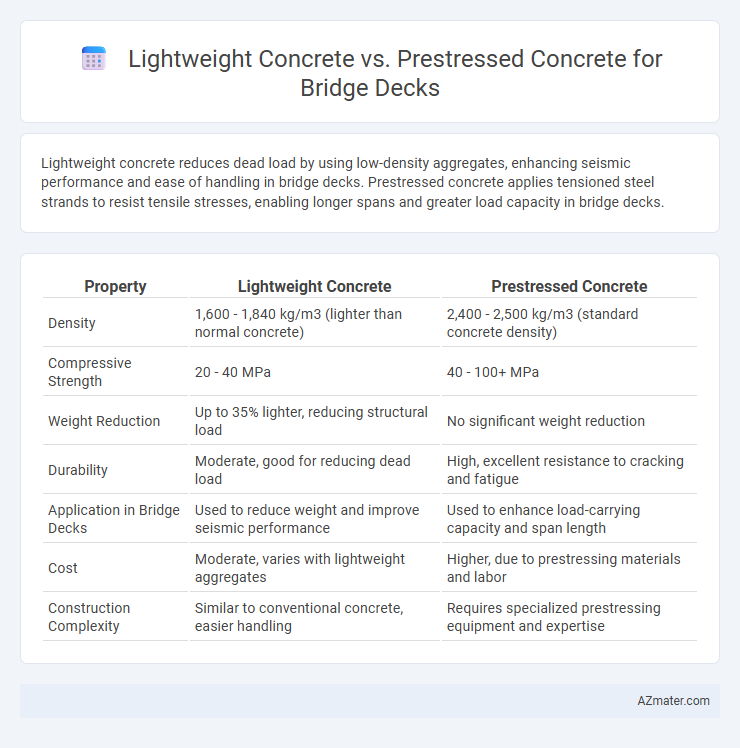Lightweight concrete reduces dead load by using low-density aggregates, enhancing seismic performance and ease of handling in bridge decks. Prestressed concrete applies tensioned steel strands to resist tensile stresses, enabling longer spans and greater load capacity in bridge decks.
Table of Comparison
| Property | Lightweight Concrete | Prestressed Concrete |
|---|---|---|
| Density | 1,600 - 1,840 kg/m3 (lighter than normal concrete) | 2,400 - 2,500 kg/m3 (standard concrete density) |
| Compressive Strength | 20 - 40 MPa | 40 - 100+ MPa |
| Weight Reduction | Up to 35% lighter, reducing structural load | No significant weight reduction |
| Durability | Moderate, good for reducing dead load | High, excellent resistance to cracking and fatigue |
| Application in Bridge Decks | Used to reduce weight and improve seismic performance | Used to enhance load-carrying capacity and span length |
| Cost | Moderate, varies with lightweight aggregates | Higher, due to prestressing materials and labor |
| Construction Complexity | Similar to conventional concrete, easier handling | Requires specialized prestressing equipment and expertise |
Introduction to Bridge Deck Materials
Lightweight concrete reduces the overall dead load of a bridge deck, improving structural efficiency and seismic performance due to its lower density and enhanced thermal insulation properties. Prestressed concrete offers superior tensile strength by introducing compressive stresses, allowing longer spans and thinner sections in bridge decks, which enhances durability and load-carrying capacity. Selection between lightweight and prestressed concrete depends on factors such as load requirements, environmental conditions, and construction budgets, influencing the longevity and performance of bridge decks.
Overview of Lightweight Concrete
Lightweight concrete for bridge decks offers reduced dead load due to its lower density, typically ranging from 90 to 115 pounds per cubic foot compared to conventional concrete's 140 to 150 pounds per cubic foot. It enhances structural efficiency by minimizing load on substructures and foundations while providing good thermal insulation and durability against freeze-thaw cycles. Commonly made with expanded shale, clay, or slate aggregates, lightweight concrete maintains adequate compressive strength, usually between 3,000 and 6,000 psi, suitable for various bridge deck applications.
Overview of Prestressed Concrete
Prestressed concrete in bridge decks uses high-strength steel tendons tensioned before or after casting, enhancing load-bearing capacity and reducing material usage compared to lightweight concrete. This method controls tensile stresses and minimizes cracking, improving durability and service life under heavy traffic loads and dynamic forces. Prestressed concrete offers superior structural performance and long-span capabilities, making it ideal for bridges requiring high strength-to-weight ratios and minimal maintenance.
Material Properties Comparison
Lightweight concrete offers reduced density and improved thermal insulation compared to prestressed concrete, making it beneficial for minimizing dead load on bridge decks. Prestressed concrete exhibits superior tensile strength and crack resistance due to internal compressive stresses induced by tensioned steel tendons. The material choice significantly impacts durability, load-bearing capacity, and long-term performance in bridge deck applications.
Structural Performance Analysis
Lightweight concrete offers reduced dead load and enhanced corrosion resistance, improving overall durability of bridge decks under cyclic loading conditions. Prestressed concrete provides superior structural performance through induced compressive stresses, reducing tensile cracking and increasing load-carrying capacity. Comparative analysis reveals prestressed concrete decks exhibit higher flexural strength and serviceability, while lightweight concrete excels in seismic resilience and thermal insulation properties.
Advantages of Lightweight Concrete for Bridge Decks
Lightweight concrete offers significant advantages for bridge decks, including reduced dead load that decreases the demand on supporting structures and foundations, leading to potential cost savings and enhanced seismic performance. Its lower density improves thermal insulation, reducing temperature-induced stresses and minimizing cracking in the deck. Additionally, lightweight concrete provides excellent workability and durability, promoting longer service life and reduced maintenance requirements for bridge infrastructure.
Benefits of Prestressed Concrete in Bridge Design
Prestressed concrete in bridge design offers superior load-bearing capacity and enhanced durability compared to lightweight concrete, reducing structural deflections and cracking under heavy traffic loads. It allows longer spans with fewer supports, minimizing construction costs and improving aesthetic appeal. The precompression effectively counteracts tensile stresses, increasing safety and extending the bridge deck's service life.
Durability and Maintenance Considerations
Lightweight concrete offers enhanced durability for bridge decks by reducing dead loads, which minimizes stress and potential cracking, leading to lower maintenance needs over time. Prestressed concrete provides superior tensile strength through internal tensioning, effectively resisting cracking and extending service life under heavy traffic loads. Both materials improve durability, but prestressed concrete typically requires fewer repairs and longer intervals between maintenance due to its controlled stress distribution and enhanced structural integrity.
Cost Implications and Life-Cycle Analysis
Lightweight concrete reduces dead load on bridge decks, potentially lowering foundation and support costs, while prestressed concrete, despite higher initial expenses due to specialized materials and labor, offers extended durability and enhanced load-carrying capacity. Life-cycle analysis shows prestressed concrete decks often provide better long-term value by minimizing maintenance and repair costs, whereas lightweight concrete may incur higher service expenses due to lower strength and greater susceptibility to cracking. Selecting between lightweight and prestressed concrete for bridge decks depends on balancing upfront investment with anticipated life-span performance and maintenance budgets.
Selection Criteria for Bridge Deck Applications
Lightweight concrete offers reduced self-weight, enhancing seismic performance and simplifying foundation design, making it ideal for long-span bridge decks where load reduction is critical. Prestressed concrete provides superior tensile strength and durability, enabling thinner deck slabs and longer spans without intermediate supports, advantageous in heavily loaded or high-traffic bridges. Selection criteria include structural load requirements, span length, durability demands, construction method, and cost considerations specific to the bridge deck application.

Infographic: Lightweight concrete vs Prestressed concrete for Bridge deck
 azmater.com
azmater.com